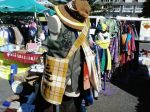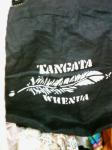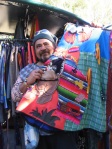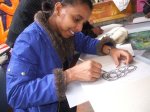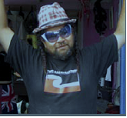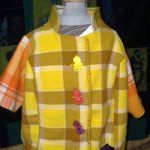It will be “hello” to a new home for design store Staple, which has moved from its upstairs room in the Poverty Bay Club to the space downstairs formerly occupied by Winston’s Bar.
And it will be “goodbye” to costume/textile designer Maungarongo (Ron) Te Kawa who, just a year after returning to his hometown of Gisborne, is taking his talents further south.
Te Kawa has created a range of quilts and wall-hangings for the reopening of Staple which, as well as stocking domestic designs, is both studio and showcase for its operators, potter Peggy Ericson and contemporary jeweller Helena Andersson.
After closing the Kaiti store where he stocked his reworked vintage clothing, Te Kawa is moving to a venue in Woodville (“don’t laugh,” he says, “the rent is cheap”) to concentrate on making the politically-charged textile pieces that are his current focus.
But it will be a few weeks yet before he gets to settle in the busy little Wairarapa town.
His first task will be to head to Christchurch — where he lived before returning to Gisborne — to salvage what remains of his possessions after the city’s two massive earthquakes.
In a week’s time he’s due at Te Papa Tongarewa: The Museum of New Zealand to lead members of the public in making a “freedom quilt” in celebration of the Maori New Year, Matariki.
Then he will be at Gisborne’s Matapuna Training Centre to teach the students how to use printing to “pimp” and outfit, after which he will ready for removal the vast swathes of fabric and the other bits and bobs that are the raw material of his work.
Even after it has all been shipped out of town at the end of the month, the effervescent artist says Gisborne won’t have seen the last of him.
Given that many of the Christchurch outlets for his textiles were wiped out by the February 22 earthquake, he’ll be maintaining a presence at Staple.
And in any case, he has another workshop booked . . . on August 6 and 7 he’ll be at Gisborne Environment Centre to teach people how to “zoosh up their linen, pimp up their suits or make a statement on clothing with printing”.
“I’m so going to miss this beautiful city,” Te Kawa says. “But I know that I will be back some day with bells on.”
Meanwhile, his won’t be the only work on show when Staple reopens its doors this evening.
Representing domestic design are Te Kawa and fellow local Deborah Clarke (tablecloths/tea towels), while artist Lauren Porter has contributed window tints/chalkboards; Sue McMillan has created cushions by upcycling New Zealand wool blankets; and Morgan Haines has made contemporary crockery with a traditional twist.
Ericson has been working on techniques that bring an intriguing translucent-but-not effect to her current work.
And Andersson has complemented her new pieces by inviting contributions from contemporary jewellers from around the country. Among the exhibitors are Aucklanders Jane Dodd, Kiri Schumacher and Maja Knall, along with Gala Van Ommen (Wellington), Kim Jobson (Waiuku) and Rangi Kipa (Whakatane).
■ Staple’s reopening exhibition will be launched tonight from 5pm.
